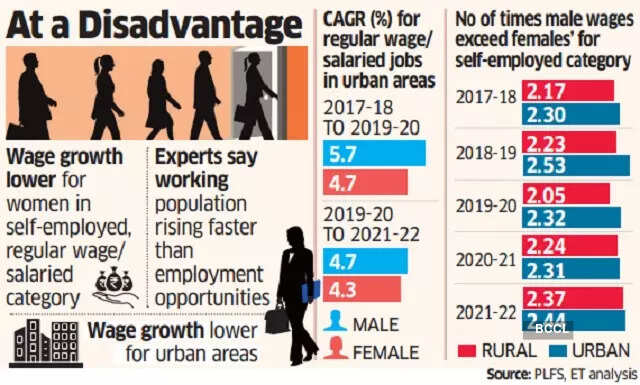- News
- 2 min read
Post-Covid, women get lower pay hikes
An ET analysis found that between 2017-18 (July-June) and 2021-22 (July-June), the annual growth rate of women's wages at 4.5% in urban areas was lower than that of men, which was 5.2%. In rural areas, wages for men increased 4.9%, compared with 4.6% for women.
Wages grew slower for women compared with men since the start of Covid, increasing the pay disparity.
An ET analysis found that between 2017-18 (July-June) and 2021-22 (July-June), the annual growth rate of women's wages at 4.5% in urban areas was lower than that of men, which was 5.2%. In rural areas, wages for men increased 4.9%, compared with 4.6% for women.
As per Periodic Labour Force Survey's annual data releases, women's wages had increased faster than men's from 2017-18 till 2019-20, but the trend reversed post-Covid, widening the gap in pay. Men earned 1.53 times more than women in rural areas in 2021-22. The gap was 1.27 times in urban areas.

Further analysis indicates the divergence is more in the self-employed category, where the proportion of women is rising. An earlier analysis by ET found that women are moving out of regular wage employment towards the self-employed category, where earnings are less than half the regular wage group.
The share of women in the self-employed category, which includes unpaid household work, went up from 51.9% to 62.1% between 2017-18 and 2021-22.
The gap between male and female wages in this category went up from 2.3 times in 2017-18 to 2.44 times in urban areas. The post-Covid slowdown in the growth of women's wages contributed to the widening pay disparity.
The growth rate of women's wages among self-employed was almost half of the wages for men between 2019-20 and 2021-22.
In rural areas, the gap widened from 2.17 times to 2.37 times, as the growth rate of wages for women declined significantly post-Covid, whereas men's wages rose faster.
"Worker population ratio for non-literate women has seen a jump from 27.7% in 2017-18 to 40.4% in 2021-22. For educated women (post-graduate and above), worker population ratio has seen a small rise during the same period," said Radhika Pandey, a senior fellow at the National Institute of Public Finance and Policy, explaining the increasing gender gap.
Worrying signals
Experts say the increasing pay disparity is disconcerting but equally disturbing is the decline in wage growth for regular and salaried employees in urban areas.
Wage growth declined from 5.3% pre-Covid to 4.7% post-Covid, even as inflation increased. The wage growth was lower than inflation since 2019-20.
"One possible reason is the cost rationalisation undertaken by companies in post-Covid period. The emphasis was on cost reduction to improve profits. Lack of gainful employment opportunities forced people to look for low-paid jobs. Construction emerged as an important source of employment but wages are lower," said Pandey.



COMMENTS
All Comments
By commenting, you agree to the Prohibited Content Policy
PostBy commenting, you agree to the Prohibited Content Policy
PostFind this Comment Offensive?
Choose your reason below and click on the submit button. This will alert our moderators to take actions